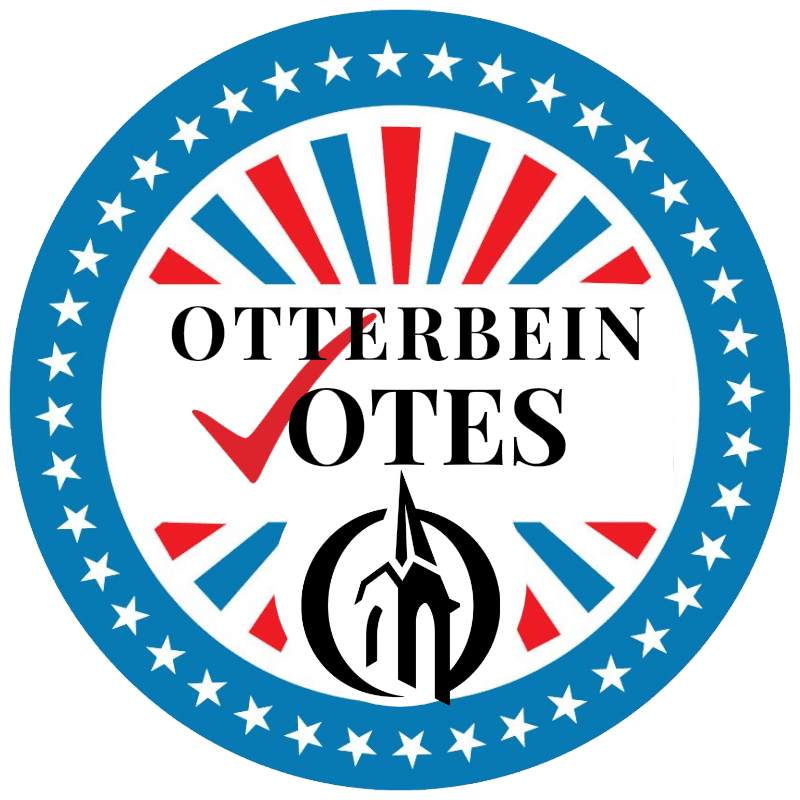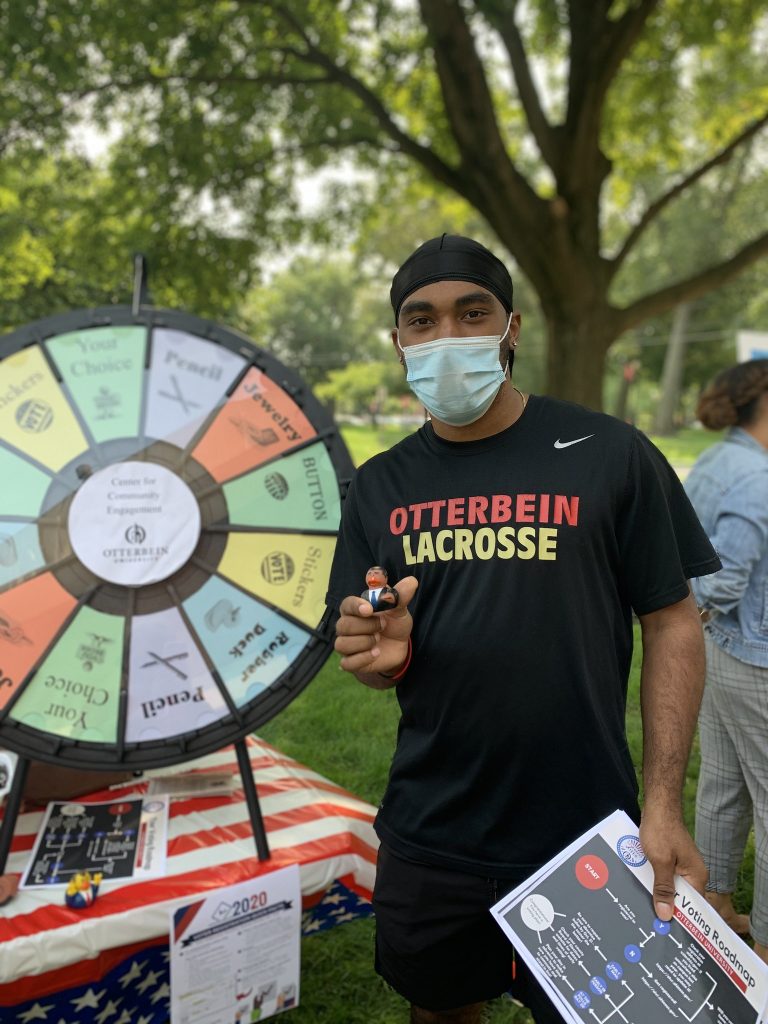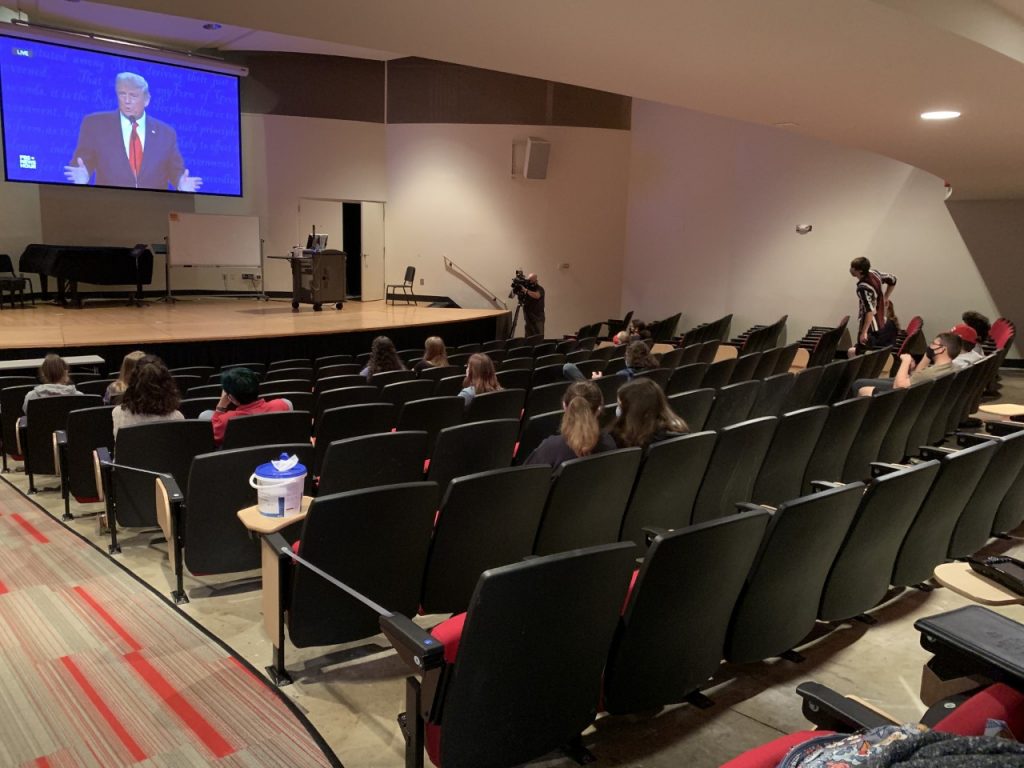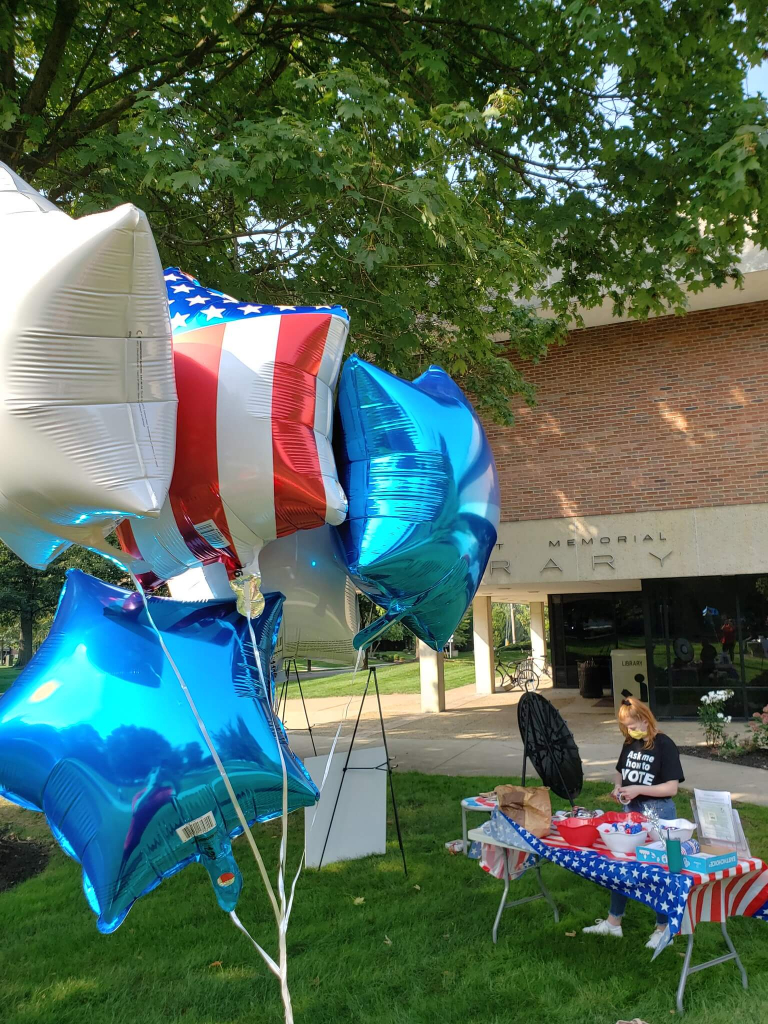Otterbein Students Contribute to Large Youth Voter Turnout
Posted Nov 03, 2020
On a warm, sunny day in September, sophomore pre-veterinary major Lindsey Payton and a few other students set up their Voter Education Table, which was filled with voter buttons, patriotic rubber ducks and informational materials. Decked out in voting-themed t-shirts, they asked everyone who walked past the library if they were registered to vote. If the answer was yes, they followed up with, “Do you have a plan to vote?”
The Constitution Day event was the kickoff of a non-partisan voter education campaign called #otterbeinVOTES, coordinated by Otterbein’s Center for Community Engagement (CCE) and the student-led group Raise Your Voice. Over 100 students stopped at the Voter Education Table that day. They also landed a story on NBC4’s local evening news.

“We find that ‘tabling’ is one of the best ways to reach out to students,” said Payton. “We provide activities like spinning a wheel to get a prize as a way to get their attention, and from there we can create a dialogue about registering and making a plan to vote.”
The #otterbeinVOTES campaign also coordinates classroom visits, educational posters, debate watch parties and more.
Efforts like these, cultivated over the last 15 years, are why Otterbein was recognized by Washington Monthly as one of America’s Best Colleges for Student Voting 2020 for its high student voter registration and student voting rates.
According to the ALL IN Campus Democracy Challenge, 68.7% of Otterbein students were registered to vote and 16.9% voted in 2014. Just four years later, 79.4% were registered to vote and 45.2% voted in the 2018 midterm election.
The students who spearhead these efforts have also received national recognition through fellowships that support their work.
This year, two students — Payton and sophomore Hannah Sturgeon — were selected by Campus Election Engagement Project (CEEP) to be CEEP Fellows. Three others senior Zach Thomson, junior Shay Locke and senior Shelby McSwords — were chosen to be Democracy Fellows by CampusVotes.
Both national organizations operate with the goal of educating and engaging students in the voting process. That process starts with registering students to vote.
Voter Registration
Payton started registering youth voters before she was able to vote herself. In response to high-profile school shootings across the country, her high school mobilized to engage in positive action. She joined her school’s voter registration effort and even worked as a poll worker before she was eligible to vote.
“Then I come to Otterbein, I’m a CardinalCorps Leader, and I’m not really sure what I wanted to get involved in. They tell me, ‘Raise Your Voice is a non-partisan group that registers people to vote,’ and I say, ‘I know how to do that!’ I guess I would say I then took it and ran with it and the amount of engagement has significantly increased over the last year,” she said.

The work is important to Payton because she believes every vote can make a difference.
“When they talk about making a difference within in their community, when they talk about wanting to change legislation, a lot of people go to protesting. And while that is a really great method, another great method is influencing the people who are in the office,” she said. “I see it as my vote is going to be the turning point in that election.”
Her peers on the #otterbeinVOTES team agree, and one way they get students to register is to tell them why their vote matters.
“As our generation comes of age to vote, it’s important for us to make our voices heard; how we vote now determines our future,” said Locke, a sociology major.
And they want youth voters to carry that message into the future.
“Your voice is always important! Although it is easy to get swept up in the excitement of a presidential election year, it is also important to remember that there will still be local candidates and issues on your ballots too. Your vote matters because you are voting on issues that will affect your lives in many ways outside of the presidential cycle,” said Sturgeon, an environmental science and political science double major.
The #otterbeinVOTES campaign relies on partnerships across campus to spread the word. Faculty and staff visited classes to educate students on the process; staff members helped organize debate watch parties; student-athletes helped with tabling; and Student Government paid for pre-stamped envelopes for students to mail in their absentee ballot requests.

And with a large population of student-athletes on campus, Head Men’s Basketball Coach Andy Winters joined the effort when he laid down the gauntlet in a friendly competition with his fellow Cardinals athletics teams. “We challenged all the teams to get 100% voter registration before Oct. 5, the voter registration deadline,” he said.
By Sept. 29, 100% of the players on the Men’s Basketball team were registered to vote. When the final results were in, Women’s Basketball, Football, Volleyball, Men’s Soccer, Men’s Lacrosse, Softball, Men’s and Women’s Golf, and Men’s and Women’s Cross Country were all 100% registered to vote. Women’s Soccer was 98% registered to vote and Women’s Lacrosse was 90% registered to vote.
The voter registration campaign on campus was a successful one, but the work doesn’t end with the registration deadline.
Keeping Student Voters Engaged
The first presidential debate viewing party on Sept. 29 was a full house. The auditorium has approximately 250 seats, but during the pandemic it safely holds 40 people. Otterbein students from every point along the political spectrum watched the debate together — socially distanced and wearing facial coverings — and engaged in civil discourse.

In the end, the three debate watch parties might not have changed any minds, but the events provided opportunities for students to engage in the voting process on campus.
After the registration deadline passes, the Democracy and CEEP fellows have to educate their fellow students on the voting process, encourage them to learn about the candidates and issues, and keep them engaged through Nov. 3 — and hopefully beyond.
“There’s a saying that you can lead a horse to water, but you can’t make them drink. We can register students to vote, but we have to keep engaging them so they follow through and vote,” said Payton.
That includes making sure registered voters have a plan to vote.
“My biggest takeaway from the #otterbeinVOTES launch on Constitution Day was that when asked, students noted that they were already registered to vote — but when we followed up and asked about their plans to vote, that’s where the uncertainty was,” said Melissa Gilbert, associate dean of experiential learning and community engagement.
For those students, they were prepared with a flow-chart handout that showed students the voting process in an easy-to-understand way.
“With a year as full of uncertainty as 2020, it is more important than ever to have a plan for where and how you are going to vote. There are plenty of options; just make sure to be proactive and think ahead when considering your ballot this year,” said Sturgeon.
Payton added, “Having a plan to vote allows you to plan out time to research both the issues and candidates that you will see on the ballot.”
The #otterbeinVOTES team also educates voters how to see a sample ballot so they can research the candidates and issues before they vote, how to track an absentee ballot through the process until it is counted, and how to spread the word to others about voting.
Voting in the 2020 Election
The 2020 election is poised to boast record youth voter participation, according to data by the Center for Information and Research on Civic Learning & Engagement, a non-partisan, independent research organization focused on youth civic engagement in the United States. When comparing Ohio data for youth ages 18-29 as of 11 days before election day, 160,400 youth voters had voted early (both in person and via mail) in 2020, compared to 48,000 in 2016.

As their numbers increase, youth voters are finding the experience to be rewarding for a variety of personal reasons.
“My favorite aspect of the overall voting experience is doing research on all the candidates; I love doing deep dives into their history, what they stand for, and seeing what they’ve done for their constituents in the past,” Locke said.
Sturgeon’s motives are a little more social: “My favorite part is getting those around me excited and involved too.”
And then there are new voters. When asked about her favorite aspect of voting, Payton sheepishly admitted that, despite registering classmates to vote since high school, “Funny story… This is my first election.”
Still, she says she is looking forward to casting per ballot and knowing that she’s done her civic duty.
“I’m going to try to be more diligent about voting in those off elections because those can influence a lot of communities as well,” she said.